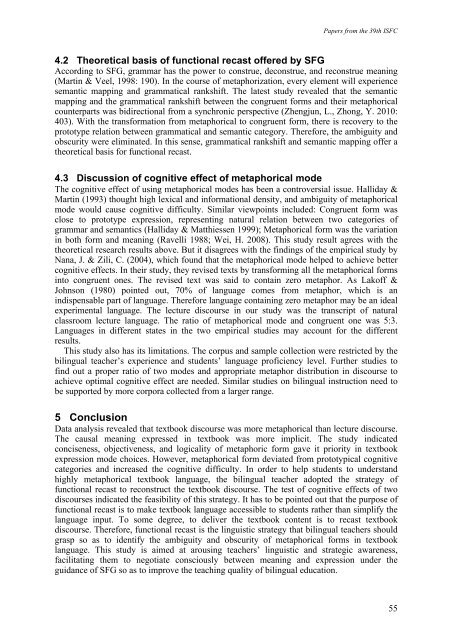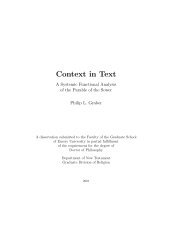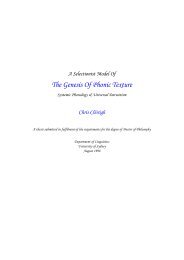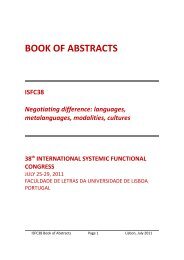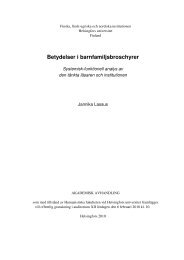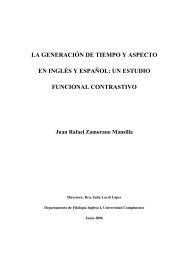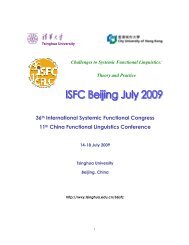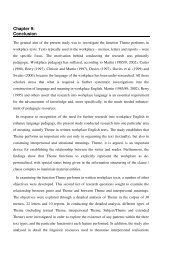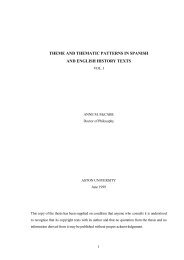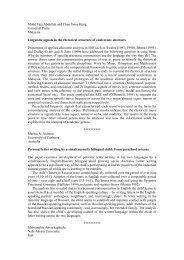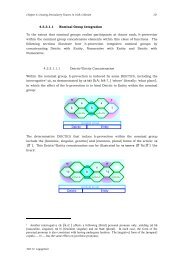the ISFC39 Proceedings - International Systemic-Functional ...
the ISFC39 Proceedings - International Systemic-Functional ...
the ISFC39 Proceedings - International Systemic-Functional ...
Create successful ePaper yourself
Turn your PDF publications into a flip-book with our unique Google optimized e-Paper software.
Papers from <strong>the</strong> 39th ISFC4.2 Theoretical basis of functional recast offered by SFGAccording to SFG, grammar has <strong>the</strong> power to construe, deconstrue, and reconstrue meaning(Martin & Veel, 1998: 190). In <strong>the</strong> course of metaphorization, every element will experiencesemantic mapping and grammatical rankshift. The latest study revealed that <strong>the</strong> semanticmapping and <strong>the</strong> grammatical rankshift between <strong>the</strong> congruent forms and <strong>the</strong>ir metaphoricalcounterparts was bidirectional from a synchronic perspective (Zhengjun, L., Zhong, Y. 2010:403). With <strong>the</strong> transformation from metaphorical to congruent form, <strong>the</strong>re is recovery to <strong>the</strong>prototype relation between grammatical and semantic category. Therefore, <strong>the</strong> ambiguity andobscurity were eliminated. In this sense, grammatical rankshift and semantic mapping offer a<strong>the</strong>oretical basis for functional recast.4.3 Discussion of cognitive effect of metaphorical modeThe cognitive effect of using metaphorical modes has been a controversial issue. Halliday &Martin (1993) thought high lexical and informational density, and ambiguity of metaphoricalmode would cause cognitive difficulty. Similar viewpoints included: Congruent form wasclose to prototype expression, representing natural relation between two categories ofgrammar and semantics (Halliday & Matthiessen 1999); Metaphorical form was <strong>the</strong> variationin both form and meaning (Ravelli 1988; Wei, H. 2008). This study result agrees with <strong>the</strong><strong>the</strong>oretical research results above. But it disagrees with <strong>the</strong> findings of <strong>the</strong> empirical study byNana, J. & Zili, C. (2004), which found that <strong>the</strong> metaphorical mode helped to achieve bettercognitive effects. In <strong>the</strong>ir study, <strong>the</strong>y revised texts by transforming all <strong>the</strong> metaphorical formsinto congruent ones. The revised text was said to contain zero metaphor. As Lakoff &Johnson (1980) pointed out, 70% of language comes from metaphor, which is anindispensable part of language. Therefore language containing zero metaphor may be an idealexperimental language. The lecture discourse in our study was <strong>the</strong> transcript of naturalclassroom lecture language. The ratio of metaphorical mode and congruent one was 5:3.Languages in different states in <strong>the</strong> two empirical studies may account for <strong>the</strong> differentresults.This study also has its limitations. The corpus and sample collection were restricted by <strong>the</strong>bilingual teacher’s experience and students’ language proficiency level. Fur<strong>the</strong>r studies tofind out a proper ratio of two modes and appropriate metaphor distribution in discourse toachieve optimal cognitive effect are needed. Similar studies on bilingual instruction need tobe supported by more corpora collected from a larger range.5 ConclusionData analysis revealed that textbook discourse was more metaphorical than lecture discourse.The causal meaning expressed in textbook was more implicit. The study indicatedconciseness, objectiveness, and logicality of metaphoric form gave it priority in textbookexpression mode choices. However, metaphorical form deviated from prototypical cognitivecategories and increased <strong>the</strong> cognitive difficulty. In order to help students to understandhighly metaphorical textbook language, <strong>the</strong> bilingual teacher adopted <strong>the</strong> strategy offunctional recast to reconstruct <strong>the</strong> textbook discourse. The test of cognitive effects of twodiscourses indicated <strong>the</strong> feasibility of this strategy. It has to be pointed out that <strong>the</strong> purpose offunctional recast is to make textbook language accessible to students ra<strong>the</strong>r than simplify <strong>the</strong>language input. To some degree, to deliver <strong>the</strong> textbook content is to recast textbookdiscourse. Therefore, functional recast is <strong>the</strong> linguistic strategy that bilingual teachers shouldgrasp so as to identify <strong>the</strong> ambiguity and obscurity of metaphorical forms in textbooklanguage. This study is aimed at arousing teachers’ linguistic and strategic awareness,facilitating <strong>the</strong>m to negotiate consciously between meaning and expression under <strong>the</strong>guidance of SFG so as to improve <strong>the</strong> teaching quality of bilingual education.55


